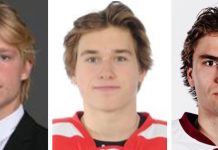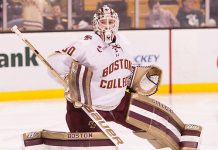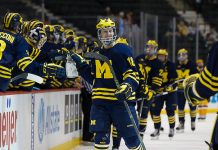This is a very exciting week for me, ladies and gentlemen.
I’m pleased to let you know that my first novel, “Robert’s Rules of Karaoke”, will be published as an e-book by TheWriteDeal starting this Sunday. While it’s certainly not a sports book, college hockey certainly has a role in the story, from a visit to Lynah Rink to a trip to the Beanpot. And lest you WCHA folks call “East Coast Bias” on me, I’m pleased to say that “In Heaven, There Is No Beer,” the Red Pepper, and Wisconsin’s 2006 NCAA championship all get shout-outs in the book as well.
Of course, that’s not why I’m here. After all, while I’m certainly not above a bit of shameless self-promotion, the real reason we come back here week after week is to discuss the Hobey Baker Award. And this week, in honor of the publication of “Robert’s Rules of Karaoke,” I’d like to present a little something I call “Elliot’s Rules of the Hobey.” You might want to listen to the Robert’s Rules playlist on Spotify or the Robert’s Rules Pandora station while you read … you know, for a little “mood music.”
If you’ve been reading the Hobey Watch for a while, a lot of this will probably seem familiar to you, since a number of themes seem to come up in the Hobey conversation year after year. However, I think it’s time we got these rules on the record without tying them to any current candidate.
Now, none of these rules are hard and fast. They’re just based on the patterns that I’ve noticed in covering college hockey and the Hobey for some nine seasons. I’ve already had one former member of the Hobey committee tell me that I’m trying to define things too much. Still, I figured I’d let you decide. So, without any further ado, here are the first five of “Elliot’s Rules of the Hobey:”
5. No player shall win the Hobey without participating in that season’s NCAA tournament or winning a championship in a previous NCAA tournament.
To borrow from another sport, and former New York Jets coach Herm Edwards, “You play to win the game.” So, no matter what a player is doing individually, if it doesn’t help his team win enough games to make it to the NCAA tournament, then Hobey probably will not be impressed. On the other hand, if you already have a pair of NCAA titles on your résumé, as Matt Carle did in 2006, then failing to make the tournament might not ruin your chances.
It does bear mentioning that there have been two exceptions to this rule: 1994 winner Chris Marinucci of Minnesota-Duluth and 1995 winner Brian Holzinger of Bowling Green. However, this was also the era of a 12-team NCAA tournament, and Holzinger’s Falcons likely would have made a 16-team tournament at 25-11-2. As for Marinucci, I don’t exactly understand that one, but with the Bulldogs winning the WCHA regular-season title the year before, he had certainly been part of a winner.
This is a rule worth keeping in mind if you’re following the Hobey candidacy of Colgate’s Austin Smith or Maine’s Spencer Abbott. Given that neither player has been to the NCAA tournament in his career, it’s imperative that the Raiders and Black Bears make it this year if they want their stars to have a chance at hoisting the Hobey. Besides, you know, that whole “make the tournament” thing. Anyway, moving on …
4. Forwards must have at least 15 goals to be considered for the Hobey.
When I write that “Hobey likes goals,” this is what I mean. If you go through the annals of Hobey history, you’ll find that the only forward to win the Hobey with fewer than 20 goals was the original Hobey winner, Minnesota’s Neal Broten in 1981. Broten also handed out 54 assists that season, of course, and there is certainly something to be said for a truly gifted setup man. That “something,” however, is generally not, “The winner of the Hobey Baker Award is …”
For those of you who think T.J. Hensick was robbed in 2007 — and we’ll get back to him shortly — it might be worth keeping in mind that Hensick’s 23 goals would have him on the low end of the scale for Hobey winners at forward. In the present, though, just remember that if you’re looking at a team with several big scorers, the guy scoring the goals is the guy you want to keep your eye on in the Hobey race.
3. Older players are favored.
In 31 years of Hobey winners, only one sophomore two sophomores and one freshman have won the Hobey. That’d be North Dakota forward Ryan Duncan in 2007 and Michigan State goalie Ryan Miller in 2001 as sophomores, and Maine forward Paul Kariya in 1993. With Kariya finishing the season with 100 points on a 42-1-2 Maine team, he’s a natural exception to the rule, as is Miller, who set the standard by which all other college goalies seem to be judged, fairly or not. As for Duncan, you can say all you want about him not being the best player on his own team, but his 31 goals were second only to Niagara’s Ted Cook among the nation’s top goal scorers Plus, he got some help from an unlikely source, which we’ll get to in a second. However, when sizing up Hobey candidates, figure that a well-qualified junior or senior will get the nod over a similarly qualified freshman or sophomore when it’s close.
2. A player’s indiscretions, on or off the ice, will not preclude him from Hobey consideration, but can make the difference in a close race.
Looking back, this is the rule that has caused the most bitterness in the years that I’ve been following the Hobey race. From Hensick in 2007 to Nathan Gerbe in 2008 to Matt Frattin last year, debating the worthiness of players who have involved themselves in controversy tends to bring out the worst in us as college hockey fans.
For what it’s worth, I spoke with a friend who was on the voting committee for the 2007 Hobey, and he agreed that Hensick’s misconduct penalty in the third period of Michigan’s NCAA tournament game against North Dakota cost him a shot at the Hobey. I probably would have voted for him regardless if I had a vote that year, but given that Hensick removed himself from Michigan’s most important game of the season, I can see where Hobey voters would have downgraded Hensick.
As for Gerbe and Frattin, obviously, their issues were very different, but they have some things in common. While there was significant fan objection to either player even being considered for the Hobey, the coaches and media members who do the voting saw fit to vote both players into their respective “Hobey Hat Tricks.” However, both Kevin Porter in 2008 and Andy Miele last season had impressive qualifications of their own, without any incidents that raised questions about character, and as a result, those players won the Hobey.
But what if it hadn’t been that way? Well, that brings me to my most important rule to remember when sizing up the Hobey race …
1. No Hobey candidate exists in a vacuum.
One of the questions that comes up each year during the Hobey Watch is whether a goalie will ever win the award again. That question, in turn, begs another question: Did Ryan Miller ruin it for his fellow netminders when he posted a 1.32 goals-against average and a .950 save percentage?
I’ve gone back and forth on this one over the years, but the more I think about it, the more I’m inclined to think that he didn’t. Sure, Miller’s numbers that year were astonishing, and something we may never see again. However, it’s worth remembering that when Cornell’s David LeNeveu backstopped Cornell to the 2003 Frozen Four, he had a great case for the Hobey with a 1.20 GAA and a .940 save percentage. However, the award went to Peter Sejna of Colorado College, who posted an astonishing 82 points that season on 36 goals and 46 assists. In the absence of those totals, it’s worth wondering whether LeNeveu might have been the Hobey winner. I think it’s quite possible.
By the same token, in the absence of Kevin Porter, Nathan Gerbe might well have been your 2008 Hobey winner, and Matt Frattin might have won it last April in a college hockey world that didn’t include Andy Miele. The lesson is that you have to keep the rest of the field in mind whenever you evaluate a player’s candidacy for the Hobey. Last week, I wrote that Jack Connolly was looking like a prohibitive favorite for the Hobey, but in the end, it’s going to come down to how he stacks up against the other top players in the country. That’s how it’s going to work every year, and as we evaluate candidates from week to week, that’s something we need to keep in mind.
So, those are the first few of my rules. Do you agree? Disagree? What rules am I missing? Leave your thoughts below, and we’ll see how the rules apply as the season goes along. In the meantime, I hope you enjoy “Robert’s Rules of Karaoke”, and also check out the book’s pages on Facebook and Twitter. Have a great week!


